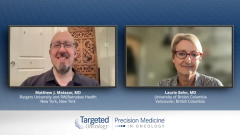
Follicular Lymphoma Workup: Risk Stratification and Staging
Key opinion leaders in the management of follicular lymphoma share their perspective on risk stratification and staging strategies to inform treatment decisionmaking.
Episodes in this series

Transcript:
Dr. Matthew Matasar: I’d love to dive into both of those pieces, both in terms of how you go about risk-stratifying patients with currently clinically relevant tools, as well as your thoughts about emerging approaches and novel ways to go about risk stratification.
Laurie Sehn, MD: Well, I think we do a relatively poor job of risk-stratifying patients. Generally, what we have available in clinical practice has largely been clinical indicators, so there are a number of clinical prognostic indices for follicular lymphoma. The first one that was developed was called the FLIPI [follicular lymphoma international prognostic index] score, and then we had FLIPI-2, and now we’ve got some modifications of the FLIPI score. They are generally prognostic scoring mechanisms that rely on either features of patients at the time of presentation, stage of disease or blood tests at the time of presentation, with hemoglobin being relevant, or elevated LDH [lactate dehydrogenase]. Putting together some of these clinical parameters, we can separate patients into better-risk and poor-risk patients.
I say the problem with the clinical risk scores is that all of our patients on those clinical risk scores do relatively well. I think even the lower-risk categories tend to do well enough that it’s very difficult to use those indicators as a way to separate treatment options for patients. So while the clinical prognostic indices that we have offer some measure of expectation, they certainly can’t be used to select therapy, and also don’t give us a real indication of biology. What we’re hoping to eventually achieve, of course, are biological measures or tools that allow us to more precisely prognosticate patients, and hopefully eventually use them as some form of a predictive marker where we can use them to select better treatments. But at this point in time, we don’t really have those biological tools.
Matthew J. Matasar, MD: There was so much excitement when we started getting emerging, sort of first looks at incorporating genomic sequencing into the risk stratification system, with models like the M7-FLIPI. It seemed like those biologically adjusted or modified models may have had greater discriminating power, but we’ve yet to see the ability to convert that into actually impacting or guiding decision-making. Do you see that coming? Do you think we’re going to get there?
Laurie Sehn, MD: You know, I do think we’re going to get there. I think part of the problem with what we’ve seen to date is that there has been some transition in treatment over time, namely the type of chemotherapy we’re using. Some of the data that emerged on patients receiving R-CHOP [rituximab, cyclophosphamide, hydroxydaunorubicin hydrochloride, vincristine, prednisone] or R-CVP [rituximab, cyclophosphamide, vincristine, prednisone], and more recently we’ve used bendamustine/rituximab, many of us in practice. What became clear from some of those studies, when there was an attempt to validate the data using different sets of patients, was that some of the genomic predictors that seemed to be valuable were no longer valuable when we switched the treatment. So I think this is still an evolution, and although some of the models that have been presented certainly are of interest and probably highlight some of the genes that are going to be relevant for prognostication, but I think what we are lacking is the validations or proof in a broader patient data set that these are relevant. I think what we learned from some of the early studies is that they may actually be specific for individual treatment. So if you change the treatment, some of the genomic indicators may no longer become relevant.
The other thing I mentioned, which I think presents a big challenge for follicular lymphoma, is that there are more studies indicating the diversity not only between patients, but also within patients. Most of the time this research relies on a singular biopsy obtained from the patient, sometimes at the time of diagnosis. We know that if we were able to sample multiple sites from that same patient—2 different nodes on 2 different sides of the body, or a bone marrow biopsy and a lymph node—and compare them, sometimes we do see very different genetic features. And so there’s clearly a subclonal process or heterogeneity even within patients that will probably make it difficult for us to validate some of the information.
I think many of us are quite excited about the fact that there’s the concept of possibly doing liquid biopsies moving forward. Not only thinking about circulating tumor DNA as a measure of minimal residual disease or disease status, but as a tool to potentially understand the genomics across a patient in a more reflective way. So I think that some of the limitations of the studies to date might, unfortunately, be due to the circumstance of follicular lymphoma in that even within patients we can be probably misguided for relying on just a singular biopsy.
Transcript edited for clarity.










































